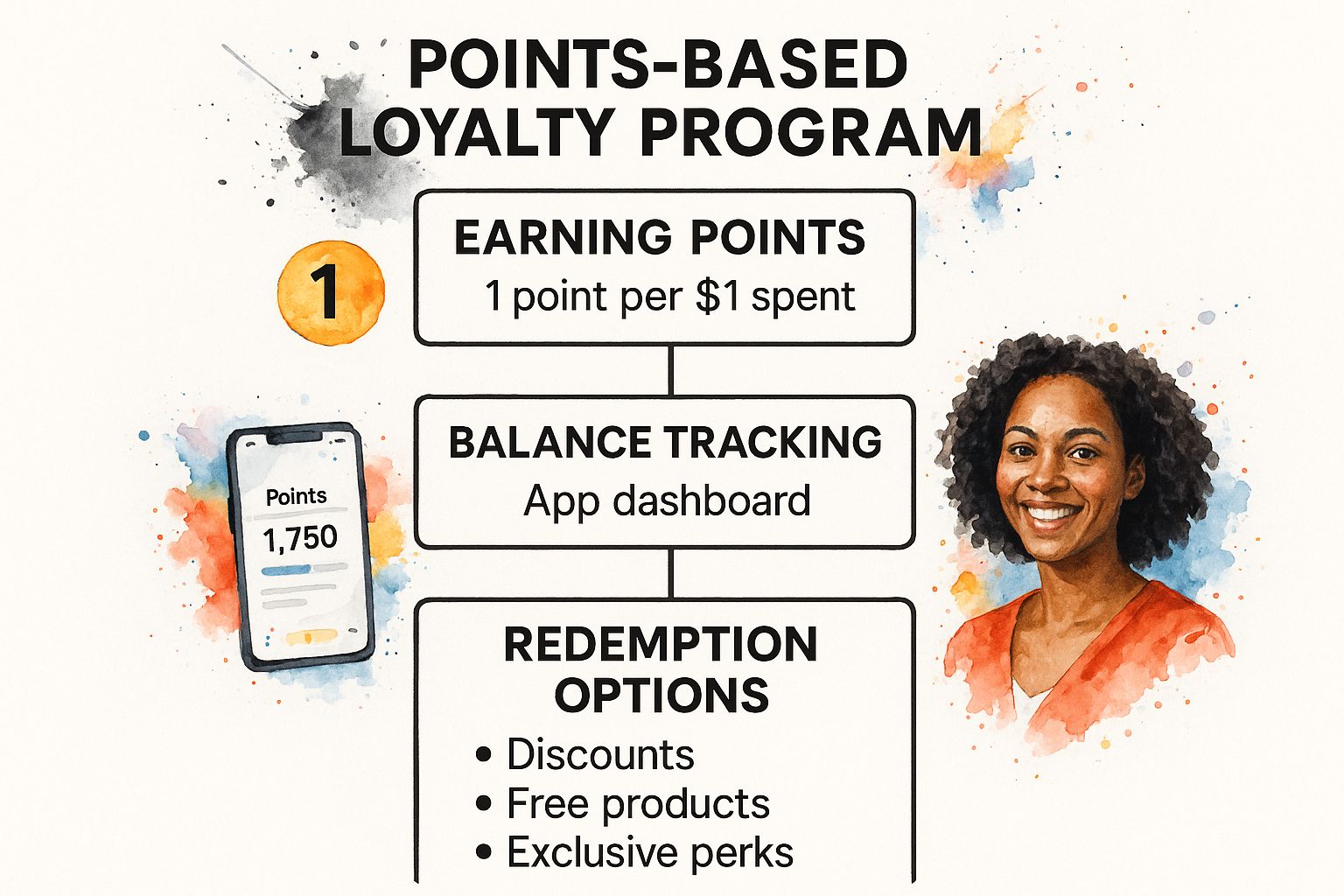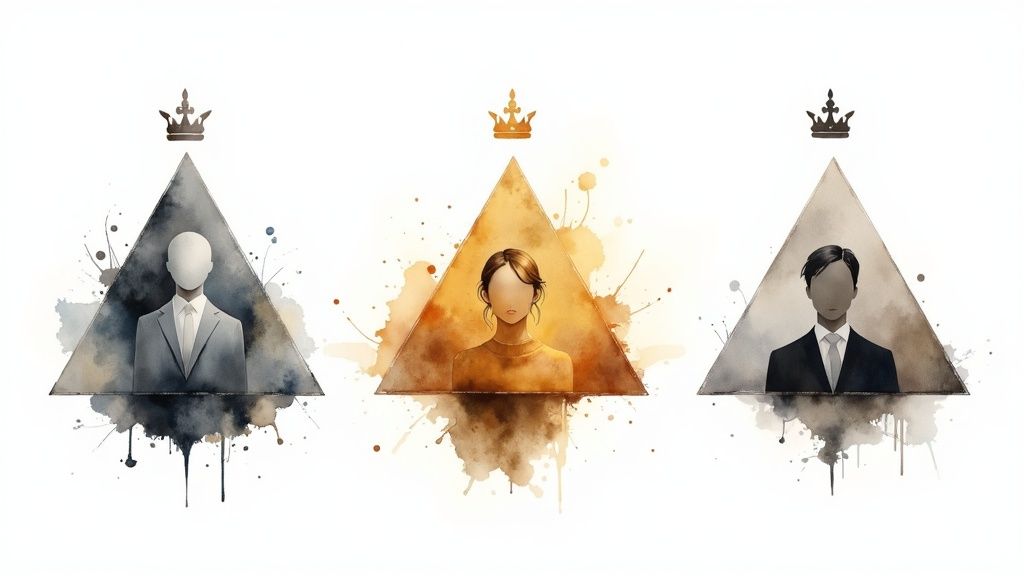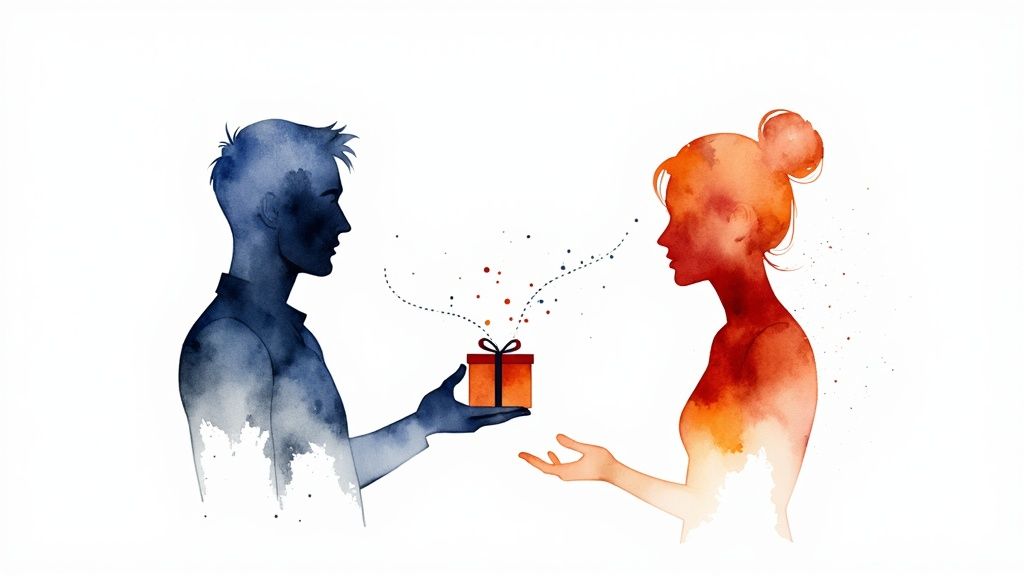You’re Building a Loyalty Program Wrong. Here’s How to Fix It.
Discover the top 10 customer reward program ideas strategies and tips. Complete guide with actionable insights.
Posted by
Let’s be honest. You’re bleeding customers. You’ve got a leaky bucket, and you think a “loyalty program” is the duct tape that will fix it. You’re probably picturing some lame points system you saw at a coffee shop. Stop. Most rewards programs are just elaborate ways to give away margin for behavior that was going to happen anyway. They’re a tax on your business, not a growth engine.
Ignore your customers, and you’ll be lucky to survive the quarter. A real rewards program isn't about bribes; it’s a weapon. It’s a system designed to change behavior, build a moat around your business, and turn your best customers into your volunteer marketing department. Forget the fluffy blog posts. This is a founder-to-founder breakdown of the models that actually work, why they work, and how not to screw them up.
1. Points-Based Loyalty Program: The Necessary Evil
Points are the table stakes of loyalty. They’re boring, but they work. Why? Because our monkey brains love seeing numbers go up. Customers get points for buying stuff, save them up, get free stuff. Simple. Predictable. It turns spending into a game.
Starbucks and Sephora built empires on this. It's not magic. It’s a dopamine loop. Don't overthink it, but don't disrespect it. If you sell things people buy often, a points system is your baseline. Get it wrong, and you look like an amateur.
How to Not Screw It Up
- Make the Math Obvious: 1 point per dollar. Done. If I need a calculator to figure out your rewards, I'm out.
- Offer Small Wins: Don't make the grand prize a trip to Mars. Give me a free coffee after five visits. Quick wins build momentum.
- Nag Them (Politely): "You're only 10 points away from a reward!" Keep the program top-of-mind, or it doesn't exist.

The takeaway: Points are a boring but effective workhorse; don't make them complicated.
2. Tiered/VIP Membership Program: The Status Game
This is where things get interesting. Tiered programs aren't about saving money; they're about status. Bronze, Silver, Gold. It’s a ladder. People will spend irrational amounts of money just to climb it. This model turns your best customers into status-seeking junkies.
Airlines perfected this. "Platinum Medallion" doesn't just mean you get a better seat; it means you're better than the guy in the back. It’s a velvet rope. You’re not selling a product anymore; you’re selling access to an exclusive club.

How to Not Screw It Up
- Make the First Rung Easy: The first tier is the hook. Let everyone in. Make them feel like they've started the journey.
- Create a Real Gap: The perks for Gold better be damn good compared to Silver. Early access, a dedicated support line, a secret handshake—make it feel earned.
- Show Them the Finish Line: "You're only $50 away from reaching Gold!" A progress bar is a powerful motivator.
- Celebrate the Level-Up: Fire some digital confetti. Send a personal email from the "founder." Make it an event.
Measuring the impact of this loyalty on your bottom line isn’t optional; it’s how you know if your tiers are just costing you money.
The takeaway: Tiers sell status, not discounts; make the climb addictive.
3. Cashback Rewards Program: The Pragmatist’s Choice
Cashback is for people who don't have time for your games. No points, no tiers, just money. It’s the most honest reward. You spend $100, you get $5 back. The end.
This works for businesses where the transaction is king. Credit cards. E-commerce sites like Rakuten. It's clean, transparent, and appeals to the customer who pulls out a spreadsheet to make purchase decisions. It builds trust because there are no tricks.
How to Not Screw It Up
- Don't Go Broke: You’re giving away cash. Know your margins cold before you offer a single percentage point.
- Automate Everything: Don't make me fill out a form to get my $2. The money should just appear. Friction kills this program.
- Hack the System (Ethically): Offer a better deal for store credit. "$10 cash back or a $12 store credit." Keep the money in your ecosystem.
- Be Brutally Clear: When and how do I get my money? Any ambiguity feels like a scam.
The takeaway: Cashback is a direct bribe; make sure your margins can handle it.
4. Referral Rewards Program: Your Unpaid Sales Army
Stop paying for ads. Your best customers are your best salespeople. A referral program gives them a cut. It’s the highest-leverage marketing you can do because it’s built on trust. An ad is noise; a recommendation from a friend is a signal.
Dropbox built an empire on this. They didn't sell anything; they gave away a product (storage) for a behavior (inviting friends). They turned every user into a growth node. It’s a virus, but a good one.

How to Not Screw It Up
- Make Sharing a One-Click Affair: Give me a link. Pre-write the email. If it takes more than five seconds, I’m not doing it.
- Reward Both People: Give my friend a discount for signing up and give me a reward when they do. This removes the social awkwardness of selling to your friends.
- Be a Tyrant About a Good Product: If your product sucks, a referral program is like pouring gasoline on a dumpster fire. You’ll just piss people off faster.
- Build a Real Army: If you want to get serious, create a formal brand ambassador program.
The takeaway: Turn your customers into recruiters, but only if your product doesn’t suck.
5. Gamification Rewards Program: The Dopamine Engine
This isn't about giving rewards. It's about making the process of earning them fun. Challenges, badges, leaderboards. You're hijacking the brain's reward system. People will complete ridiculous "quests" just to get a shiny digital badge that costs you nothing.
Nike Run Club is the masterclass. They don't just track your run; they turn it into a global competition with monthly challenges and achievement badges. They made running a video game. It creates an emotional hook a 10% coupon can't touch. For web3-native brands, this means designing reward quests with Web3 marketing automation.
How to Not Screw It Up
- Don't Be Cringey: Your "game" has to match your brand. A luxury watch company shouldn't have cartoon badges. Know your audience.
- Mix Easy and Hard: Give them an easy "win" on day one. Then create long-term challenges that keep them hooked.
- Keep It Fresh: A stale leaderboard is a dead leaderboard. New challenges, new rewards. Keep the game evolving.
The goal isn't just to reward buying, it's to reward engagement. Understand how gamification boosts customer engagement before you write a single line of code.
The takeaway: Make loyalty a game, and people will play for free.
6. Subscription/Paid Membership Program: The Golden Handcuffs
This is the boldest move. You ask customers to pay you for the privilege of being loyal. Sounds insane, right? Wrong. Amazon Prime. A paid program forces a psychological commitment. "I paid for this, so I better use it." It creates a moat of pure sunk cost fallacy.
Once someone pays your fee, they will bend their buying habits to justify it. They will choose you over a cheaper competitor because it makes their membership "worth it." You get recurring revenue and a customer who is financially and psychologically locked in.
How to Not Screw It Up
- The Value Must Be a No-Brainer: The perks have to be worth 5x-10x the fee. Free shipping, exclusive content, deep discounts. The math has to be overwhelmingly in their favor.
- Offer a Free Taste: A 30-day trial gets them hooked on the benefits. Once they've experienced VIP life, going back to general population sucks.
- Show Them the Money: "You saved $287 this year with your membership." Constantly reinforce the value to prevent churn.
The takeaway: A paid program locks customers in; just make sure the price of the key is a steal.
7. Experiential Rewards Program: The Unforgettable Bribe
Anyone can offer a discount. It’s forgettable. A unique experience? That’s a story. That’s a memory. This is for brands that understand their customers want to feel something, not just own something.
Lululemon gives free yoga classes. Sephora gives its best customers access to makeup artist workshops. These aren't rewards; they're investments in community and identity. No one brags on Instagram about the 15% they saved. They brag about the cool thing you let them do.
How to Not Screw It Up
- Make It On-Brand: If you sell hiking boots, the reward should be a guided hike, not a spa day. Authenticity is everything.
- Use Exclusivity: Don't offer it to everyone. Make it a reward for your top 1%. Scarcity creates desire.
- Team Up: Can't run an event yourself? Partner with another cool, non-competing brand. Share the cost, double the audience.
The takeaway: Sell memories, not discounts, and they’ll never forget you.
8. Coalition/Partnership Loyalty Program: The Power Alliance
You’re a small fish. You can’t compete with the big guys' loyalty programs. So don't. Team up. A coalition program lets customers earn points at your coffee shop, a local bookstore, and the movie theater down the street. It creates a network effect.
Suddenly, your small program has the scale of a giant. The shared value makes the whole ecosystem stickier. The customer is less likely to leave any single business because they'd lose the benefits across the network. It’s business strategy by way of The Avengers.
How to Not Screw It Up
- Choose Your Allies Wisely: Partner with brands that your customers already love. Your audiences should overlap, but your products shouldn't.
- Sign a Prenup: Figure out the rules before you launch. Data sharing, costs, who owns the customer. Get it in writing. Ambiguity will kill the partnership.
- The Tech Can't Suck: The experience must be seamless. If my points don't sync instantly between partners, the whole thing feels broken and I lose trust in everyone involved.
The takeaway: Join forces with non-competitors to build a program bigger than any of you could alone.
9. Value-Based/Charitable Rewards Program: The Halo Effect
This is for when your customer cares about more than just themselves. Instead of a discount, their purchase plants a tree or donates a meal. You're not just selling a product; you're selling a mission. The reward is a feeling of doing good.
TOMS and Patagonia built their entire brands on this. People don't just buy their stuff; they buy into their philosophy. This creates a bond that is almost impossible for a competitor to break with a simple price cut. It’s loyalty built on shared values.
How to Not Screw It Up
- Be Authentic or Die: If you’re a fast-fashion brand, don’t suddenly pretend you care about the environment. Customers can smell a phony a mile away. Your cause has to be in your company’s DNA.
- Give Them a Choice: Let the customer pick between a few charities. Giving them agency makes the act more personal and powerful.
- Show, Don't Tell: Don't just say "we donated." Show the pictures. Share the stories. Prove the impact. Make it real.
The takeaway: Align your rewards with a cause, and you’ll attract customers who buy your beliefs, not just your product.
10. Hybrid/Personalized Rewards Program: The Scalpel
Stop using a hammer. A hybrid program is a surgical tool. It mixes and matches all the models above, but—and this is the critical part—it uses data to give each customer the reward they actually want.
Amazon doesn’t give everyone the same offer. It looks at your history and says, "You buy sci-fi books, here’s a deal on the new Andy Weir. You also get free shipping (Subscription) and 5% back with our card (Cashback)." It’s a custom-built loyalty machine for an audience of one. It feels like they’re reading your mind. This is how you win. You stop guessing and start knowing.
How to Not Screw It Up
- Start with Segments: You don't need an army of data scientists on day one. Group customers: big spenders, frequent shoppers, one-timers. Target them differently.
- Let Them Choose: Ask them what they prefer. A discount? Early access? Free shipping? Their answers are the most valuable data you'll ever get.
- Test Everything: Don't assume your "personalized" offer is better. A/B test it against a generic control. Let the data tell you if you're a genius or an idiot. It's how you truly figure out how to increase customer lifetime value.
- Don't Be Creepy: Be transparent about how you’re using data. Give customers control. The line between "mind-reader" and "stalker" is thin.
The takeaway: The future of loyalty is personal; use data to treat different customers differently.
Customer Reward Program Ideas Comparison
| Program Type | Implementation Complexity 🔄 | Resource Requirements ⚡ | Expected Outcomes 📊 | Ideal Use Cases 💡 | Key Advantages ⭐ |
|---|---|---|---|---|---|
| Points-Based Loyalty Program | Medium to High - tech infrastructure needed | Medium - tracking & reward costs | Encourages repeat purchases, measurable customer data | Retail, hospitality, e-commerce with repeat purchase | Simple, flexible, scalable, builds emotional connection |
| Tiered/VIP Membership Program | High - multi-level tracking & differentiation | High - benefit management | Motivates higher spend, status-driven loyalty | Businesses with broad customer value distribution | Creates exclusivity, motivates advancement, personalizes |
| Cashback Rewards Program | Medium to High - simpler tech, direct costs | Medium to High - cash value impact | Immediate tangible savings, appeals to budget-conscious | E-commerce, retail, credit cards with healthy margins | Simple, transparent, builds trust |
| Referral Rewards Program | Low to Medium - tracking and software needed | Low to Medium - reward budget | Drives customer acquisition, viral growth potential | Network effect businesses, subscriptions, high satisfaction | Low cost acquisition, leverages trust, scalable |
| Gamification Rewards Program | High - app dev, design, ongoing updates | High - development & content | Increases engagement, emotional connection, social sharing | Mobile app brands, younger demographics, engagement focus | Fun, competitive, multiple touchpoints |
| Subscription/Paid Membership Program | High - benefit delivery and management | High - infrastructure and perks | Predictable revenue, committed customer base | High-frequency purchase businesses with strong value prop | Recurring revenue, higher customer lifetime value |
| Experiential Rewards Program | Medium to High - event coordination, planning | Medium to High - event costs | Builds emotional connections, brand differentiation | Lifestyle, luxury brands, community-focused businesses | Unique experiences, social sharing, emotional loyalty |
| Coalition/Partnership Program | High - coordination, shared tech platforms | High - shared systems & governance | Broad reach, rich data, cross-brand value | Small to medium businesses, complementary brands | Expanded earning, cost sharing, network effects |
| Value-Based/Charitable Rewards Program | Medium - partnerships & transparency needed | Medium - donations & management | Emotional loyalty, brand purpose alignment | Purpose-driven, socially conscious, sustainability brands | Builds purpose, emotional ties, positive social impact |
| Hybrid/Personalized Rewards Program | Very High - AI, data, omnichannel required | Very High - tech, data scientists | Max engagement through personalization, optimized ROI | Large enterprises, omnichannel retailers, diverse segments | Highly relevant, flexible, data-driven, competitive edge |
Final Thoughts
We just ran through the entire arsenal of customer reward program ideas. If you’re still thinking about this as a "marketing expense," you've missed the entire point. A loyalty program isn't a feature. It's a product. It’s a core part of your business designed to manipulate the two most important metrics: customer lifetime value and acquisition cost.
Your biggest competitor isn't your real enemy. Your real enemy is customer indifference. A generic, copy-paste rewards program is a symptom of that indifference. It tells your customers you don't know them and you don't care.
Key Takeaways: Don't Be Generic
Here’s the hard truth: a generic program is worse than nothing. It's a waste of money and a signal of incompetence.
- Value Isn’t a Coupon: The best rewards are status, access, and community. Stop thinking like an accountant and start thinking like a psychologist.
- Complexity is a Bug, Not a Feature: If I need a manual to understand your program, you’ve failed. It should be insultingly simple.
- Emotion Trumps Logic: A program that makes me feel smart, special, or virtuous will always beat one that just saves me a few bucks.
Your Next Move: Stop Guessing, Start Building
Don't just pick one of these ideas out of a hat. Look at your business. What is the one behavior you need to change right now? More repeat purchases? More referrals? Higher AOV? Pick the model that attacks that one problem.
Start small. Test it on a segment of your users. Measure the results. A loyalty program is not a "set it and forget it" project. It's a machine you have to constantly tune. Get it right, and it will print money. Get it wrong, and it’s just another line item on the P&L on your way to zero.
Stop building what you think your customers want and let Backsy.ai run the Voice of Customer analysis that tells you what they'll actually pay for.